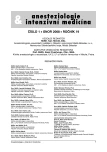Some aspects of molecular biology in critically ill patients in the context of current laboratory medicine
Authors:
M. Průcha; S. Peková; Lenka Sedláčková
Authors‘ workplace:
Oddělení klinické biochemie, hematologie a imunologie, Nemocnice Na Homolce, Praha
Published in:
Anest. intenziv. Med., 19, 2008, č. 1, s. 5-8
Category:
Intensive Medicine
Overview
Biomarkers are recognized as objective indicators of normal biological processes, pathogenic processes or pharmacological responses to a therapeutic intervention.
Sepsis is a multifactorial disease distinguished by the paucity of diagnostic tests (biomarkers) available. New biomarkers allow for a better understanding of the pathogenesis of diseases and better stratification of patients in connection with improved clinical decision making, diagnosis and treatment. New technologies – genomics and proteomics – enable multiplex detection and evaluation of biomarkers. The goal of the diagnostics at present is the implementation of new technologies and molecular approaches into routine clinical practice with emphasis on therapeutic consequences that could make “personalized medicine“ a real option.
Keywords:
biomarkers – genomics – molecular biology – proteomics – sepsis
Sources
1. Marshall, J. C. Such stuff as dreams are made on: mediator – directed therapy in sepsis. Nature Rev. Drug Discovery, 2003, 2, p. 391–405.
2. Beutler, B., Hoebe, K., Du, X., Ulevitch, R. J. How we detect microbes and respond to them: the Toll-like receptors and their transducers.
3. Volk, H. D., Reinke, P., Kraus, D. et al. Monocyte deactivation – rationale for a new therapeutic strategy in sepsis. Intensive Care Med., 1996, 22, Suppl. 4, p. 474–481.
4. Sedláčková, L., Průcha, M., Dostál, M. Immunological monitoring of sepsis using flow citometry – quantitation of monocyte HLA-DR expression and granulocyte CD64 expression. Epidemiol. Mikrobiol. Imunol., 2005, 54, s. 54–61.
5. Wesche, D. E., Lomar-Neira, J. L., Perl, M. et al. Leukocyte apoptosis and its significance in sepsis and shock. J. Leukocyte Biology, 2005, 78, p. 1–13.
6. Hong, J., Lejny, E., Fraser, A. G. et al. TLR2, TLR4 and TLR9 polymorphisms and Crohn’s disease in a New Zealand Caucasian cohort. J. Gastroenterol. Hepatol., 2007, 22, 11, p. 1760–1766.
7. Baccala, R., Hoebe, K., Kono, D. H. et al. TLR-dependent and TLR-independent pathways of type I interferon induction in systemic autoimmunity. Nat. Med., 2007, 13, 5, p. 543–551.
8. Tang, A. H., Brunn, G. J., Cascalho, M., Platt, J. L. Pivotal advance: Endogenous pathway to SIRS, sepsis, and related conditions. J. Leucocyte Biology, 2007, 82.
9. Eichacker, P. Q., Parent, C., Kalil, A. et al. Risk and the efficacy of antiinflammatory agents: retrospective and confirmatory studies of sepsis. Am. J. Respir. Crit. Care Med., 2002,166, p. 1197–1205.
10. Toft, P. The effect of surgical stress, endotoxin induced sepsis and extracorporeal circulation on the cell mediated immunity. Dan. Med. Bull., 2002, 49, 4, p. 302–317.
11. Simon, L., Gauvin, F., Amre, D. K. et al. Serum procalcitonin and C-reactive protein levels as markers of bacterial infection: a systematic review and meta-analysis. Clin. Infect. Dis., 2004, 15, 39, 2, p. 206–217.
12. Oberholzer, A., Sousa, S. M., Tschoeke, S. K. et al. Plasma cytokine measurements augment prognostic scores as indicators of outcome in patients with severe sepsis. Shock, 2005, 23, 6, p. 488–493.
13. Davis, B. H. Improved diagnostic approaches to infection/sepsis detection. Expert. Rev. Mol. Diagn., 2005, 5, p. 193–207.
14. Kellum, J. A., Kong, L., Fink, M. P. et al. Understanding the inflammatory cytokine response in pneumonia and sepsis. Results of the genetic and inflammatory markers of sepsis (GenIUS) Study. Arch. Intern. Med., 2007, 35, p. 1061–1067.
15. Průcha, M., Maťoška, V. PIRO systém „P“ (predispozice) a sepse. Anesteziologie a intenzivní medicína, 2005, 4, s. 203–210.
16. Sterus, T., Pohlak, N., Echtenacher, B., Mannel, D. N. Divergence of protection induce by bacterial products and sepsis-induced immune suppression. Infect. Immun., 2005, 43, p. 4905–4912.
17. Kollef, M. H. The importance of appropriate initial antibiotic therapy for hospital-acquired infections. Am. J. Med., 2003, 115, 7, p. 582–584.
18. Chuang, T. P., Laramie, J. M., Meyer, D. J. et al. Molecular diagnostics in sepsis: from bedside to bench. J. Am. Coll. Surg., 2006, 203, p. 585–598.
Labels
Anaesthesiology, Resuscitation and Inten Intensive Care MedicineArticle was published in
Anaesthesiology and Intensive Care Medicine

2008 Issue 1
Most read in this issue
- The management of severe acute pancreatitis – state of the art
- Polyneuropathy and myopathy of critically ill patients – what’s new?
- Current treatment of sepsis in children
- Blood purification and acute renal failure: the timing, method selection and dosing of renal replacement therapy
